Abstract
BACKGROUND: We created a standardized model of severe Staphylococcus aureus endophthalmitis in the aphakic rabbit eye to test various treatment strategies involving corticosteroid administration in addition to vitrectomy and antibiotic treatment. MATERIALS AND METHODS: In 71 aphakic New Zealand albino rabbit eyes, experimental endophthalmitis was created by injecting 10(5) colony-forming units of Staphylococcal aureus. The animals were divided into 5 groups. One control group was followed up without treatment, while 4 groups were treated with vitrectomy and intraocular cefazolin injection. Two groups were also treated with intramuscular methylprednisolone, 1 group beginning on the day of surgery and 1 group beginning on the following day. In the final group, dexamethasone, 400 micrograms, was injected into the vitreous cavity at the close of surgery. Culture results were compared on the first 2 days after surgery. Inflammatory scores, including development of total corneal opacity, were assessed over a 21-day follow-up period, and histopathologic grading was carried out at the conclusion of the clinical observations. RESULTS: Simultaneous administration of systemic corticosteroids beginning on the day of vitrectomy decreased inflammatory scores 1 week after institution of therapy but did not affect final scores. Delay of initiation of intramuscular corticosteroid until the first postoperative day negated the positive effects. Administration of intraocular corticosteroids was associated with an increase in inflammatory scores throughout the period of observation, an increase in percentage of eyes that developed opaque corneas, an increase in choroidal inflammation graded moderate or severe, and an increase in retinal necrosis compared with vitrectomy and cefazolin injection alone. CONCLUSIONS: This data suggest caution in the use of intraocular corticosteroids in treatment of severe endophthalmitis.
Full text
PDF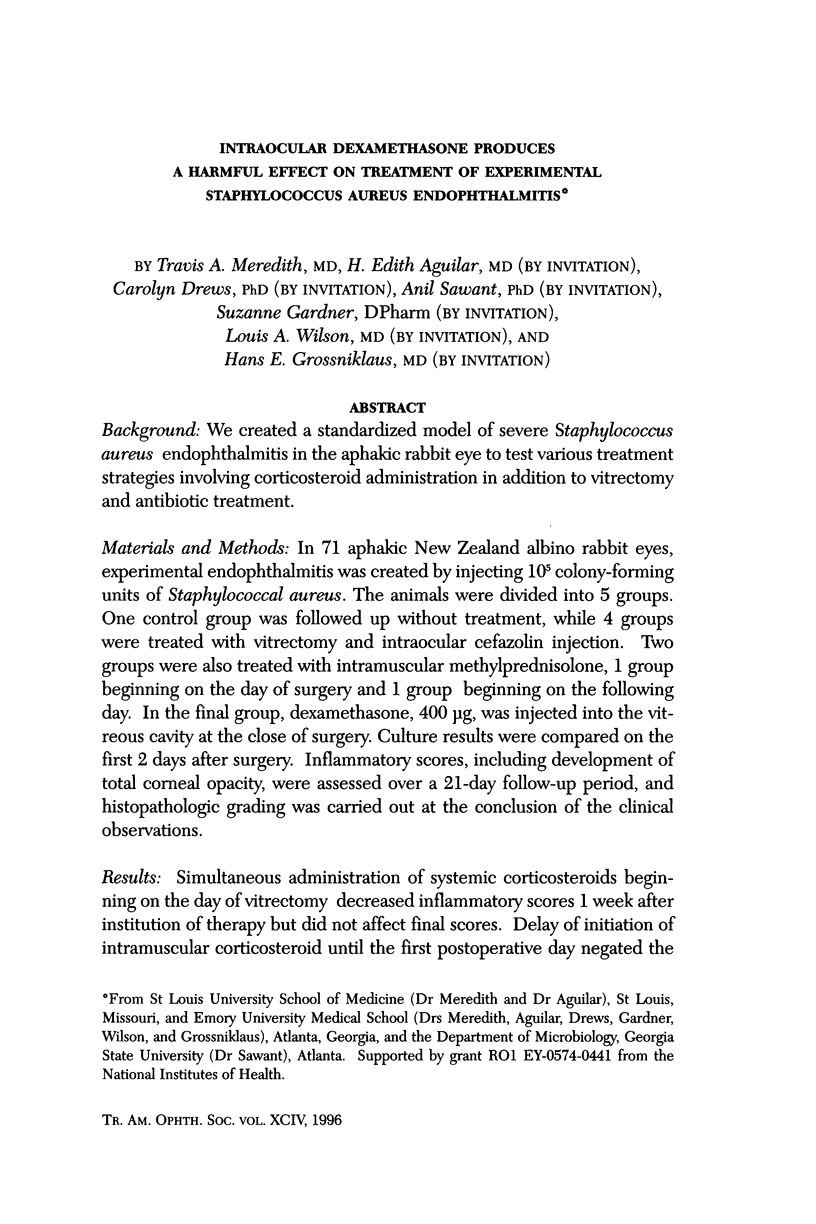
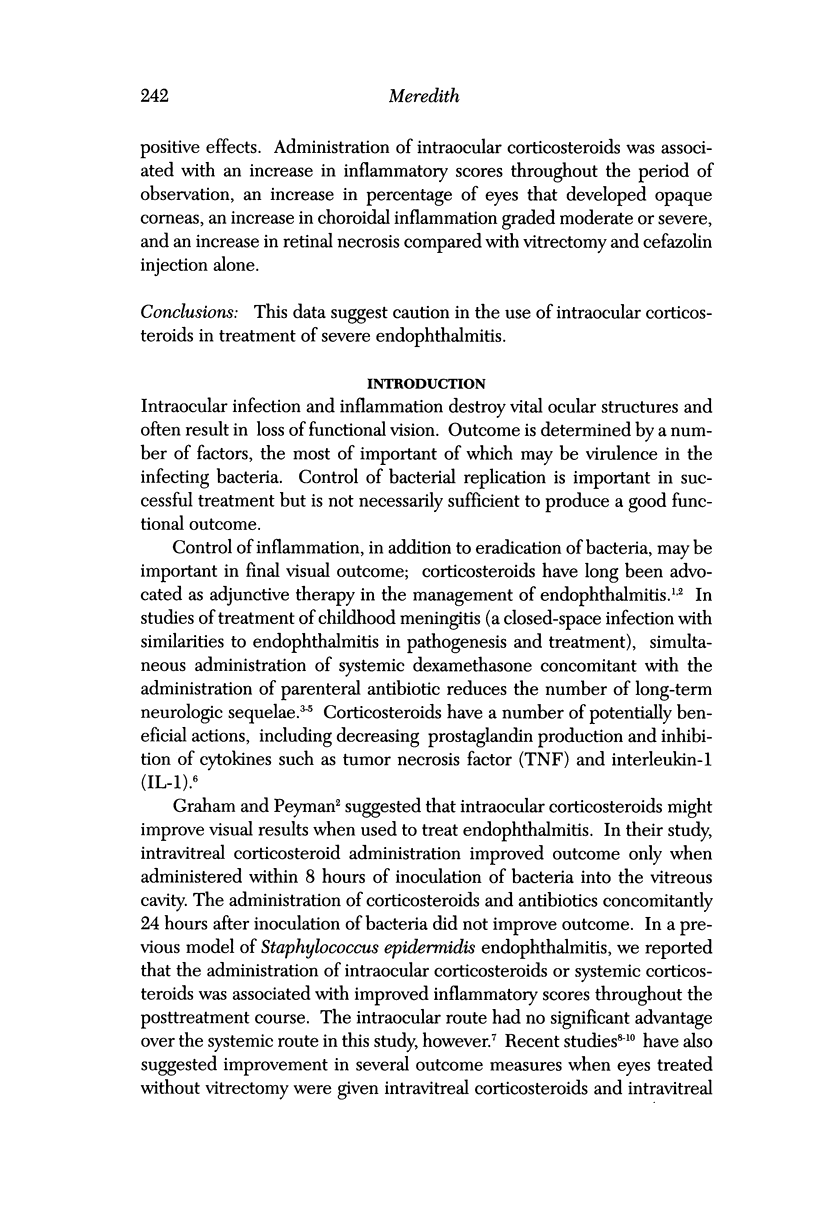

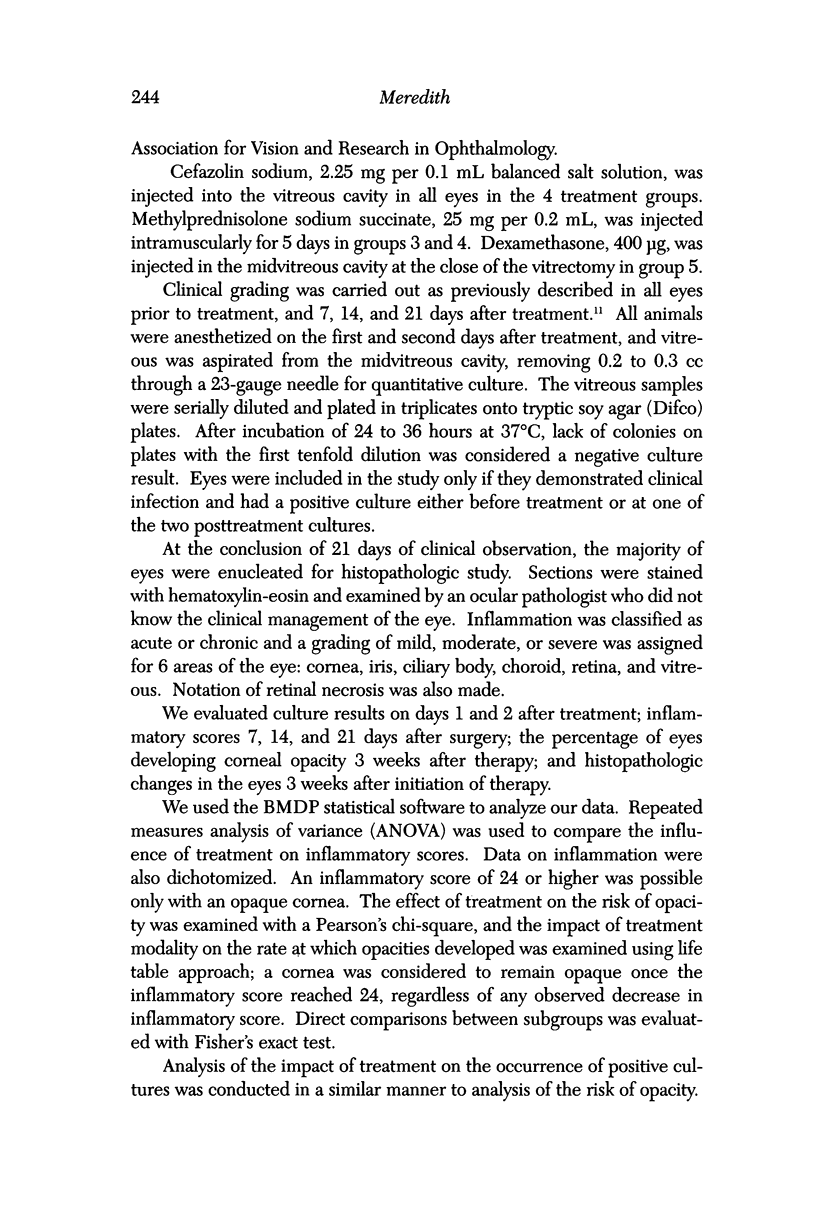

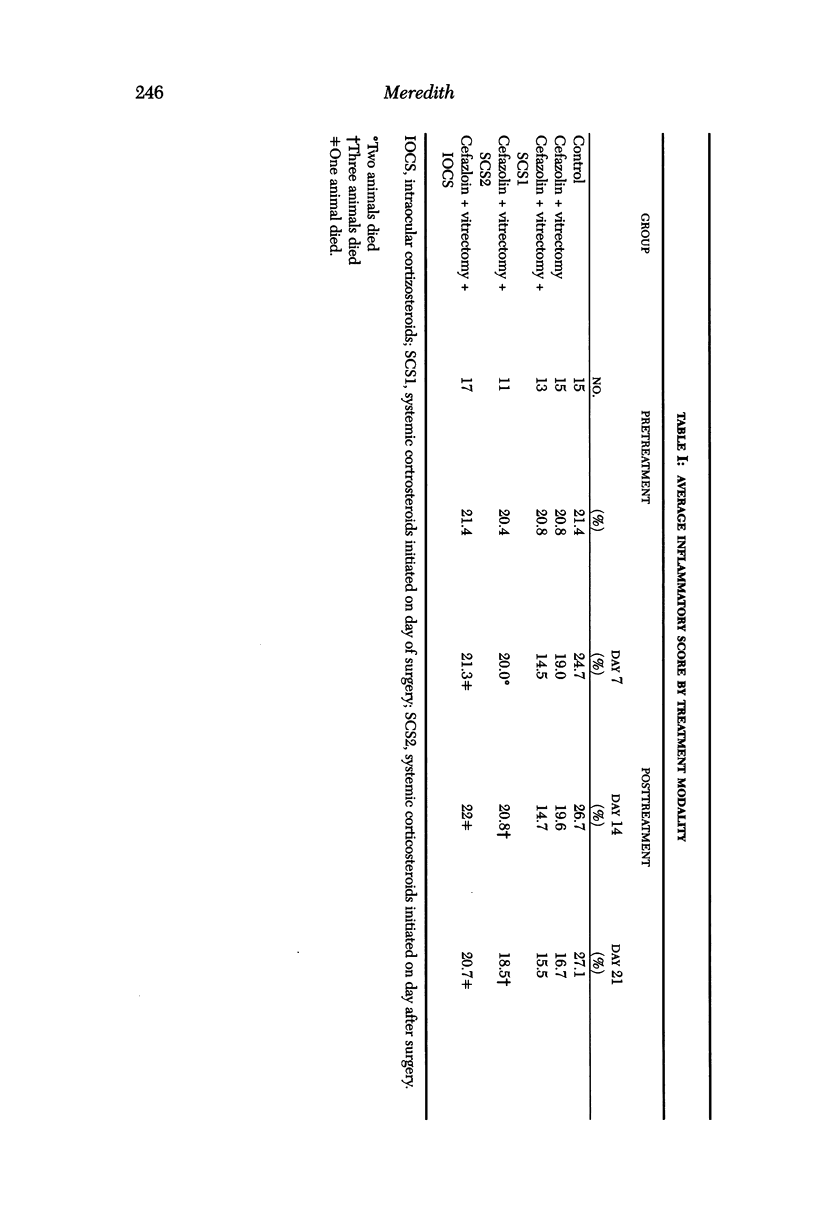
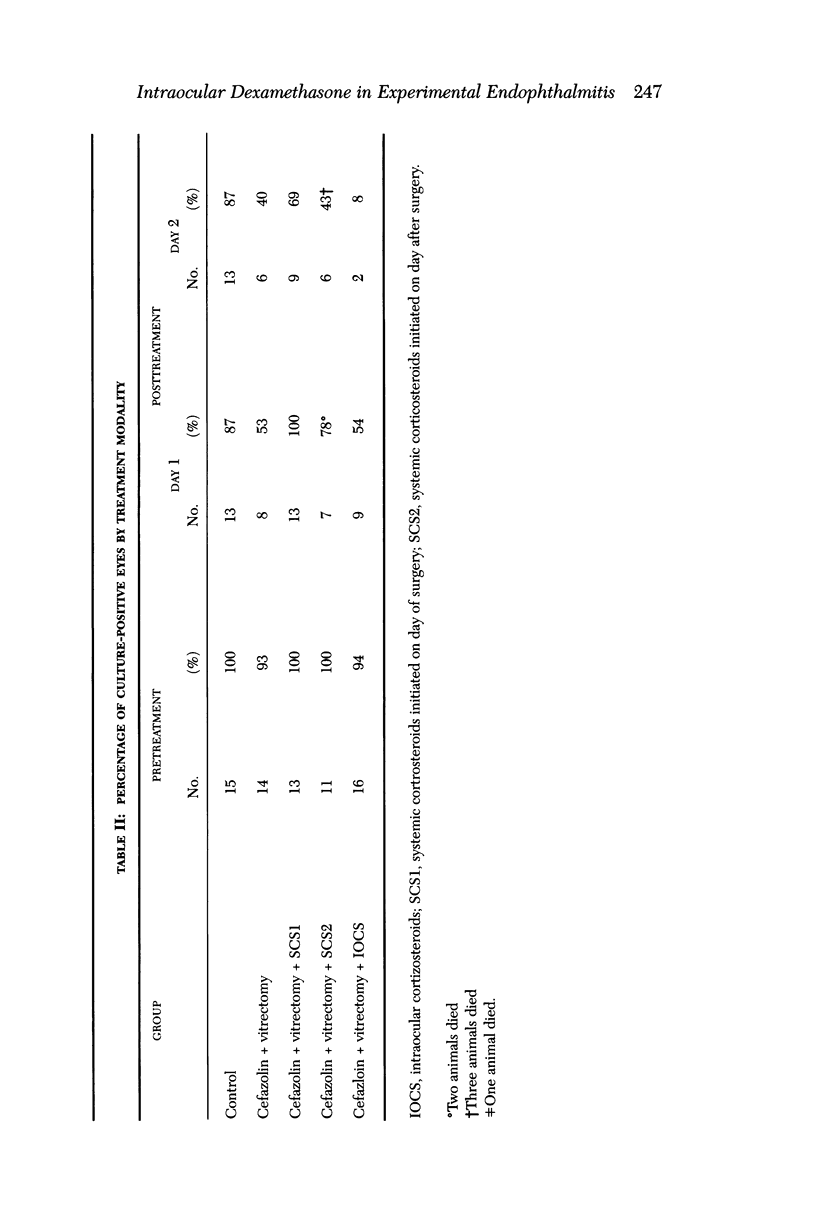
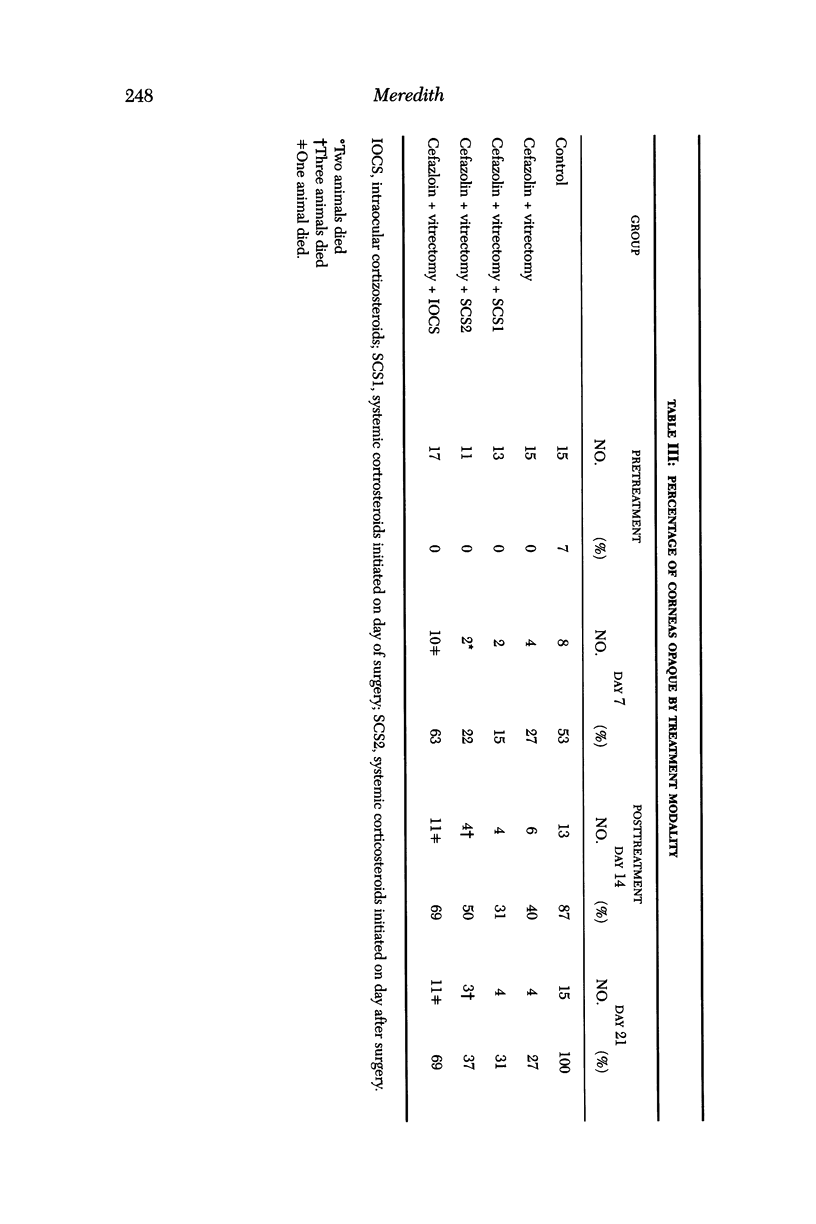
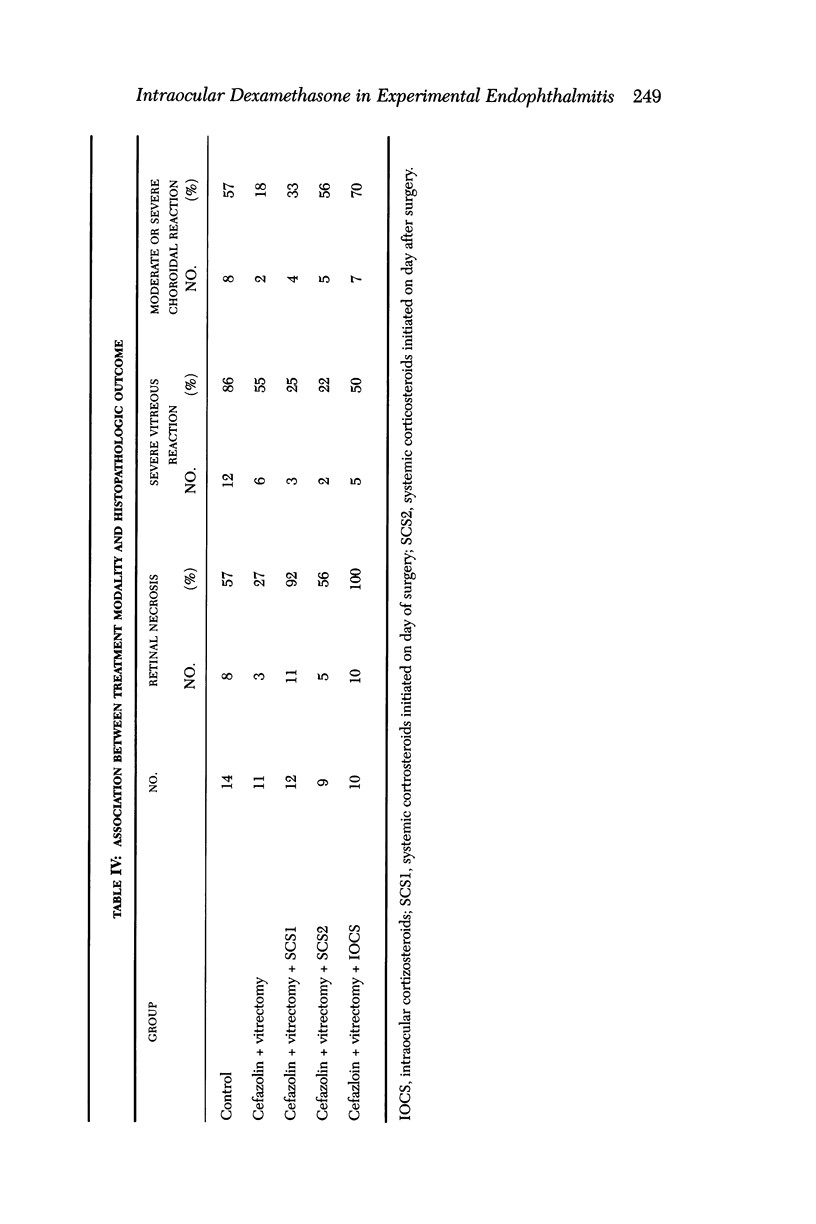

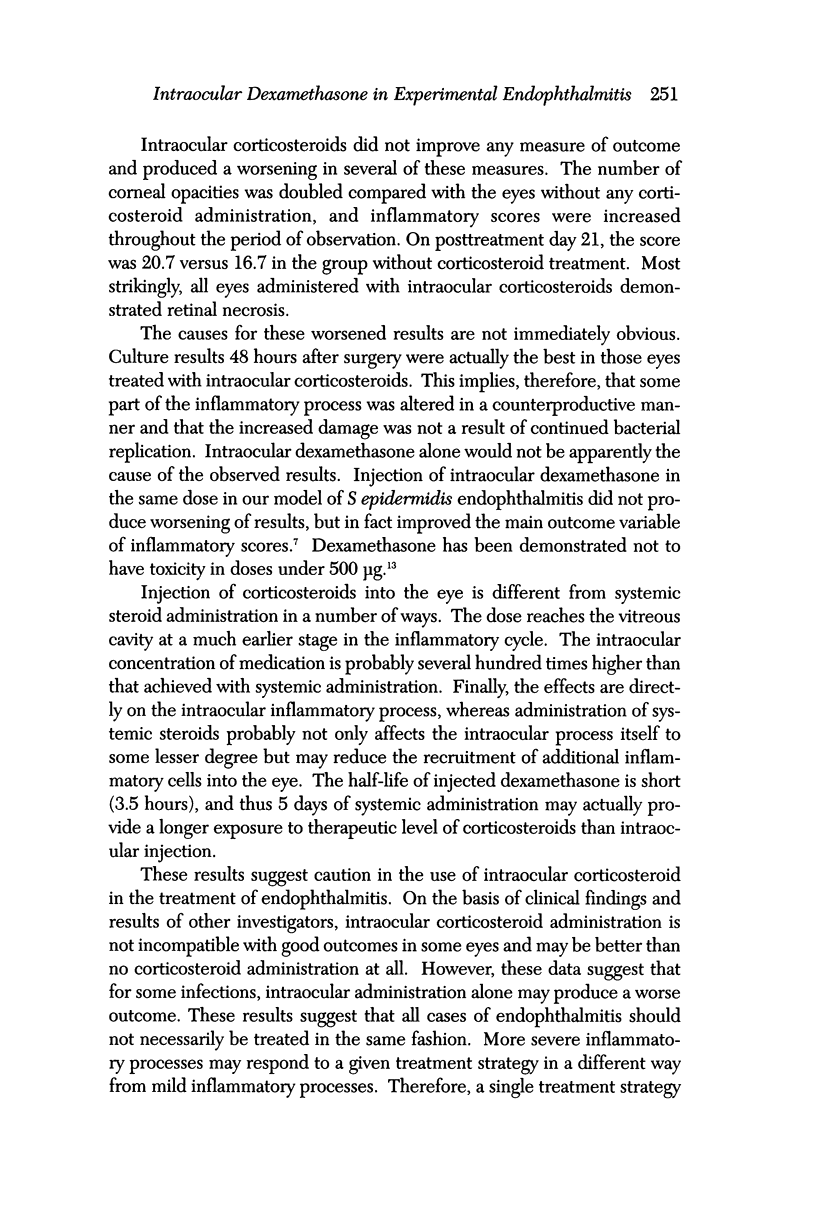
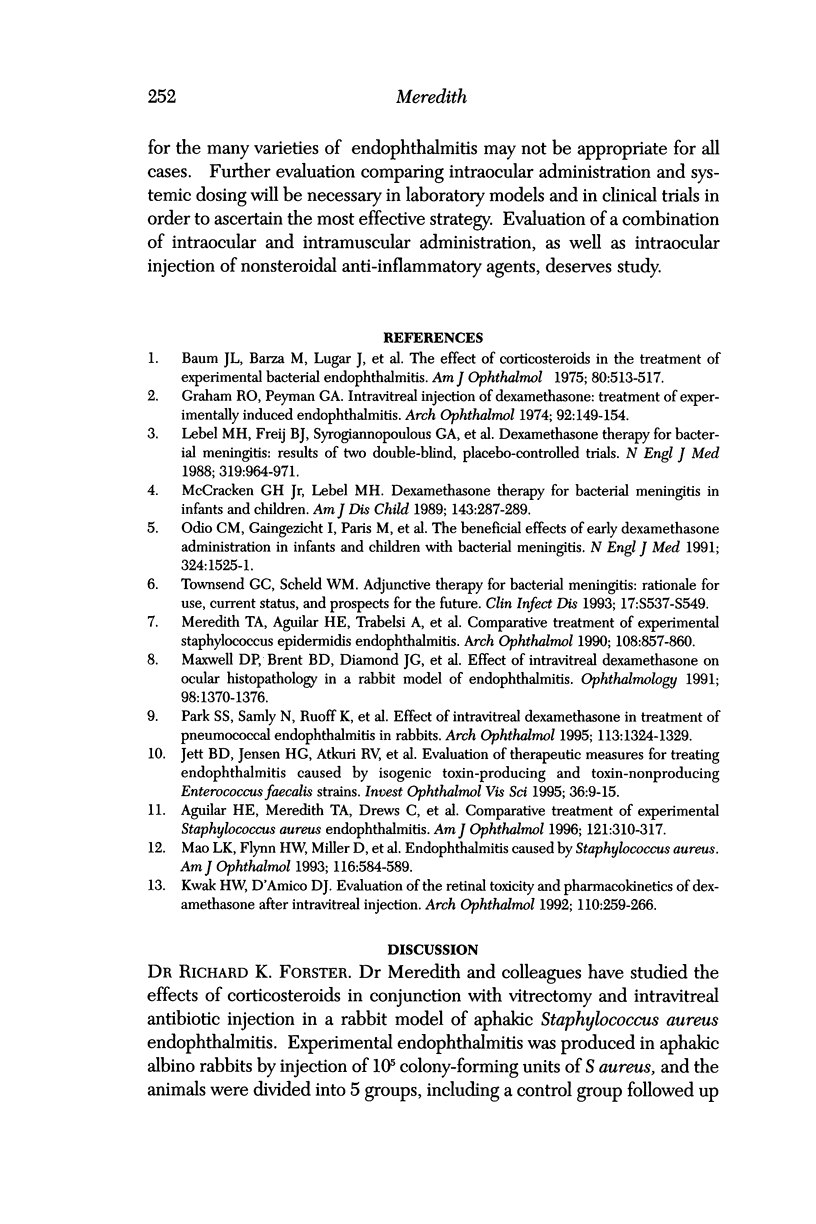
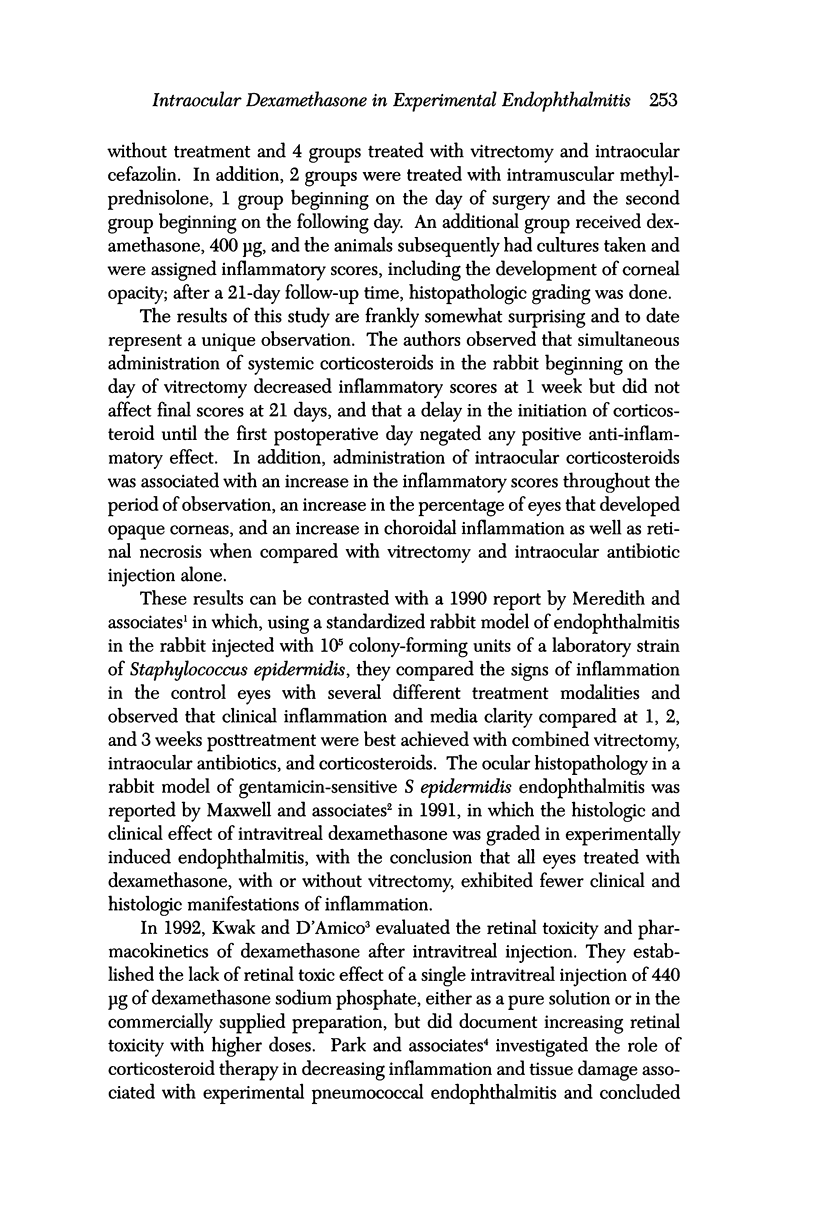
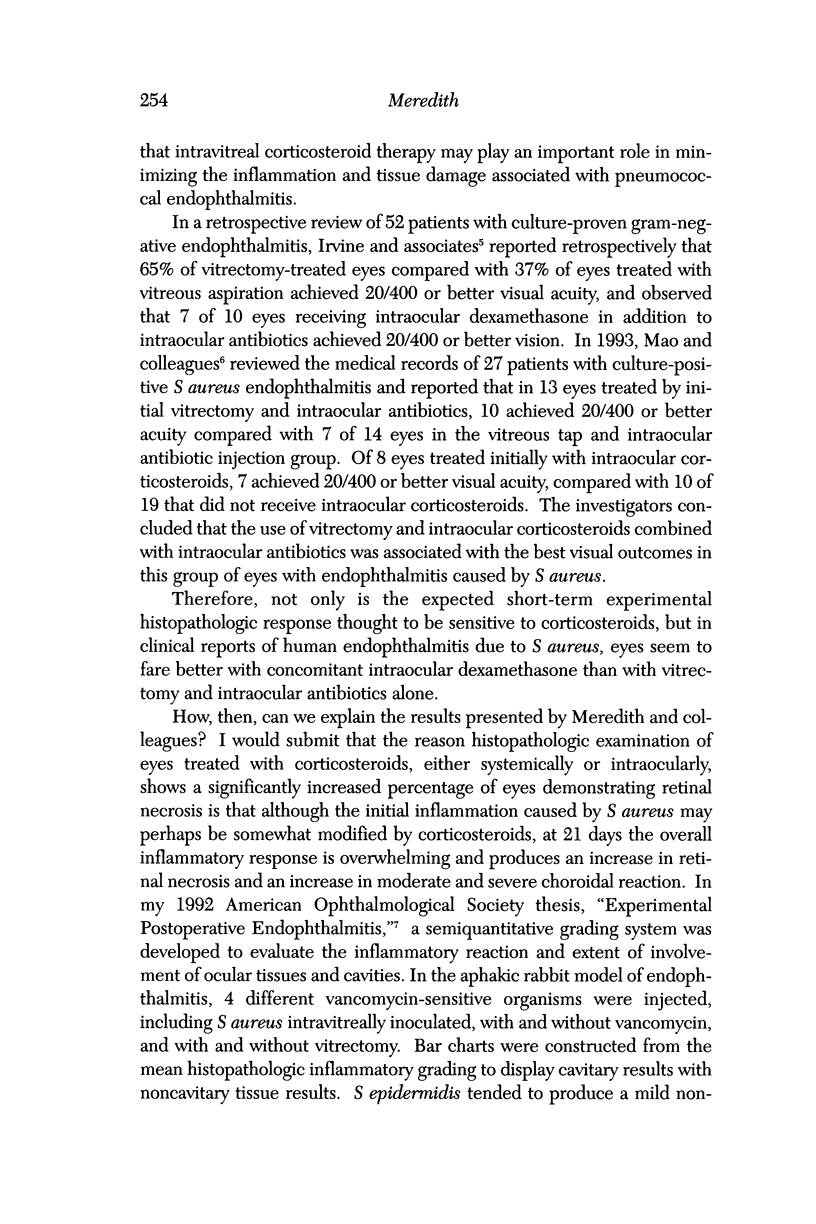
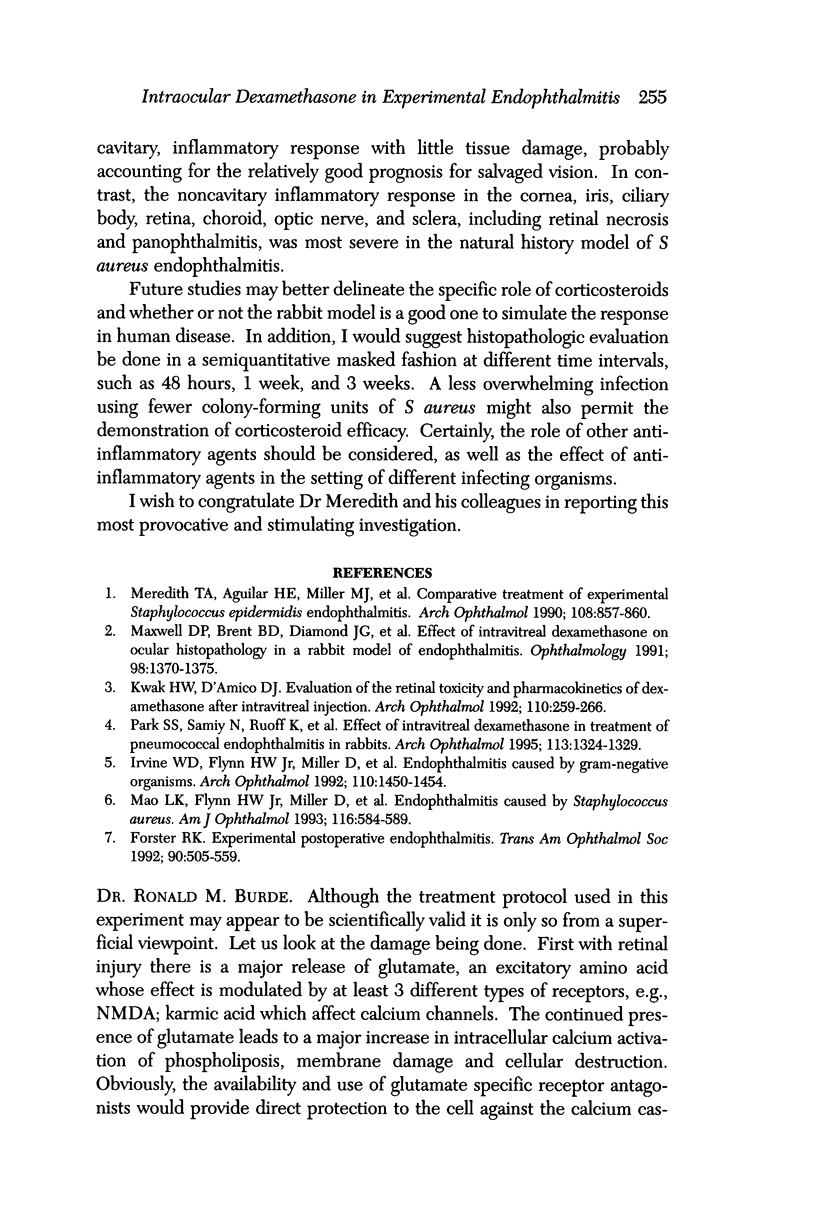


Selected References
These references are in PubMed. This may not be the complete list of references from this article.
- Aguilar H. E., Meredith T. A., Drews C., Grossniklaus H., Sawant A. D., Gardner S. Comparative treatment of experimental Staphylococcus aureus endophthalmitis. Am J Ophthalmol. 1996 Mar;121(3):310–317. doi: 10.1016/s0002-9394(14)70280-6. [DOI] [PubMed] [Google Scholar]
- Baum J. L., Barza M., Lugar J., Onigman P. The effect of corticosteroids in the treatment of experimental bacterial endophthalmitis. Am J Ophthalmol. 1975 Sep;80(3 Pt 2):513–515. doi: 10.1016/0002-9394(75)90218-4. [DOI] [PubMed] [Google Scholar]
- Forster R. K. Experimental postoperative endophthalmitis. Trans Am Ophthalmol Soc. 1992;90:505–559. [PMC free article] [PubMed] [Google Scholar]
- Graham R. O., Peyman G. A. Intravitreal injection of dexamethasone. Treatment of experimentally induced endophthalmitis. Arch Ophthalmol. 1974 Aug;92(2):149–154. doi: 10.1001/archopht.1974.01010010155016. [DOI] [PubMed] [Google Scholar]
- Irvine W. D., Flynn H. W., Jr, Miller D., Pflugfelder S. C. Endophthalmitis caused by gram-negative organisms. Arch Ophthalmol. 1992 Oct;110(10):1450–1454. doi: 10.1001/archopht.1992.01080220112031. [DOI] [PubMed] [Google Scholar]
- Jett B. D., Jensen H. G., Atkuri R. V., Gilmore M. S. Evaluation of therapeutic measures for treating endophthalmitis caused by isogenic toxin-producing and toxin-nonproducing Enterococcus faecalis strains. Invest Ophthalmol Vis Sci. 1995 Jan;36(1):9–15. [PubMed] [Google Scholar]
- Kwak H. W., D'Amico D. J. Evaluation of the retinal toxicity and pharmacokinetics of dexamethasone after intravitreal injection. Arch Ophthalmol. 1992 Feb;110(2):259–266. doi: 10.1001/archopht.1992.01080140115038. [DOI] [PubMed] [Google Scholar]
- Kwak H. W., D'Amico D. J. Evaluation of the retinal toxicity and pharmacokinetics of dexamethasone after intravitreal injection. Arch Ophthalmol. 1992 Feb;110(2):259–266. doi: 10.1001/archopht.1992.01080140115038. [DOI] [PubMed] [Google Scholar]
- Lebel M. H., Freij B. J., Syrogiannopoulos G. A., Chrane D. F., Hoyt M. J., Stewart S. M., Kennard B. D., Olsen K. D., McCracken G. H., Jr Dexamethasone therapy for bacterial meningitis. Results of two double-blind, placebo-controlled trials. N Engl J Med. 1988 Oct 13;319(15):964–971. doi: 10.1056/NEJM198810133191502. [DOI] [PubMed] [Google Scholar]
- Mao L. K., Flynn H. W., Jr, Miller D., Pflugfelder S. C. Endophthalmitis caused by Staphylococcus aureus. Am J Ophthalmol. 1993 Nov 15;116(5):584–589. doi: 10.1016/s0002-9394(14)73200-3. [DOI] [PubMed] [Google Scholar]
- Mao L. K., Flynn H. W., Jr, Miller D., Pflugfelder S. C. Endophthalmitis caused by Staphylococcus aureus. Am J Ophthalmol. 1993 Nov 15;116(5):584–589. doi: 10.1016/s0002-9394(14)73200-3. [DOI] [PubMed] [Google Scholar]
- Maxwell D. P., Jr, Brent B. D., Diamond J. G., Wu L. Effect of intravitreal dexamethasone on ocular histopathology in a rabbit model of endophthalmitis. Ophthalmology. 1991 Sep;98(9):1370–1375. doi: 10.1016/s0161-6420(91)32108-0. [DOI] [PubMed] [Google Scholar]
- Maxwell D. P., Jr, Brent B. D., Diamond J. G., Wu L. Effect of intravitreal dexamethasone on ocular histopathology in a rabbit model of endophthalmitis. Ophthalmology. 1991 Sep;98(9):1370–1375. doi: 10.1016/s0161-6420(91)32108-0. [DOI] [PubMed] [Google Scholar]
- McCracken G. H., Jr, Lebel M. H. Dexamethasone therapy for bacterial meningitis in infants and children. Am J Dis Child. 1989 Mar;143(3):287–289. doi: 10.1001/archpedi.1989.02150150041013. [DOI] [PubMed] [Google Scholar]
- Meredith T. A., Aguilar H. E., Miller M. J., Gardner S. K., Trabelsi A., Wilson L. A. Comparative treatment of experimental Staphylococcus epidermidis endophthalmitis. Arch Ophthalmol. 1990 Jun;108(6):857–860. doi: 10.1001/archopht.1990.01070080101043. [DOI] [PubMed] [Google Scholar]
- Meredith T. A., Aguilar H. E., Miller M. J., Gardner S. K., Trabelsi A., Wilson L. A. Comparative treatment of experimental Staphylococcus epidermidis endophthalmitis. Arch Ophthalmol. 1990 Jun;108(6):857–860. doi: 10.1001/archopht.1990.01070080101043. [DOI] [PubMed] [Google Scholar]
- Odio C. M., Faingezicht I., Paris M., Nassar M., Baltodano A., Rogers J., Sáez-Llorens X., Olsen K. D., McCracken G. H., Jr The beneficial effects of early dexamethasone administration in infants and children with bacterial meningitis. N Engl J Med. 1991 May 30;324(22):1525–1531. doi: 10.1056/NEJM199105303242201. [DOI] [PubMed] [Google Scholar]
- Park S. S., Samiy N., Ruoff K., D'Amico D. J., Baker A. S. Effect of intravitreal dexamethasone in treatment of pneumococcal endophthalmitis in rabbits. Arch Ophthalmol. 1995 Oct;113(10):1324–1329. doi: 10.1001/archopht.1995.01100100112040. [DOI] [PubMed] [Google Scholar]
- Park S. S., Samiy N., Ruoff K., D'Amico D. J., Baker A. S. Effect of intravitreal dexamethasone in treatment of pneumococcal endophthalmitis in rabbits. Arch Ophthalmol. 1995 Oct;113(10):1324–1329. doi: 10.1001/archopht.1995.01100100112040. [DOI] [PubMed] [Google Scholar]
- Townsend G. C., Scheld W. M. Adjunctive therapy for bacterial meningitis: rationale for use, current status, and prospects for the future. Clin Infect Dis. 1993 Nov;17 (Suppl 2):S537–S549. doi: 10.1093/clinids/17.supplement_2.s537. [DOI] [PubMed] [Google Scholar]


